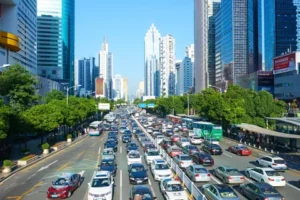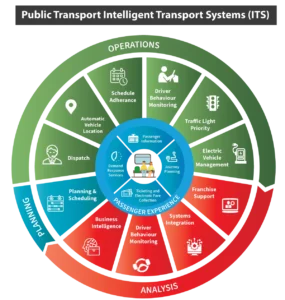Resource Hub
Introduction: ITS Evaluation Guide
Published August 29, 2022 in ITS Evaluation Guide
Why Intelligent Transport Systems for public transport?
Public transport has become an essential part of city economies as governments address residents’ needs and how they live, work and play. Cities want to effectively supply services and create opportunities while addressing climate change concerns and reduce commute times.
Many cities and countries already face enormous challenges in meeting population needs. Providing housing, education, health care, and employment opportunities are critical to improving lives and driving economies forward.
Cities use 78% of the world’s energy and produce 60% of global greenhouse gas emissions – but only occupy 2% of the world’s land space[1]. Cities are at the forefront of dealing with climate change and pollution impacts. From increasingly severe storms, abnormal snowfalls, unpredictable rainfall and rising sea levels, climate change is affecting cities right now.
These extreme weather events have the most significant impact in urban areas where the population is the densest and property value is the highest.
Severe storms, fire, flooding, and higher temperatures also directly affect human health and safety. Annual global CO2 emissions are rising, and by 2019, there were 36 billion tonnes emitted – up from 22 billion tonnes in 1990[2]. While greenhouse gases have many contributors, transport accounts for 23% of global carbon dioxide emissions – which have more than doubled since 1970[3]. Transport emissions have also grown the fastest of any energy end-use sector, with 80% of this occurring from road vehicles using internal combustion engines.
Governments are committed to reducing these emissions, with most countries signing up for net-zero carbon emissions by 2050[4]. Public transport has a significant role to play by shifting commutes from private vehicles to more environmentally friendly modes like rail transport and electric vehicles. This mode shift is becoming more important in cities as they become bigger and denser. Some will simply run out of space for private cars.
It has become clear that increasing road infrastructure levels will not cater for the transport demands of urbanised areas and that funds have not been invested in transport areas that deliver the most value. Let’s look at some case studies that demonstrate what happens when investment is placed in roads versus public transport.
Case Study: Congestion – just build more roads
Spending money to ‘just build more roads’ sums up the approach of many cities when dealing with increasing congestion in the 20th century. Increased populations and motor vehicle caused increased traffic congestion, and the solution was to build more roads. This scenario causes governments to undertake large and expensive road infrastructure projects. However, because of what economists call ‘induced demand’, these new roads become heavily congested again in a short period.

Economists Matthew Turner and Giles Duranton[5] examined this issue in 2009 and discovered a nearly perfect one to one relationship between road infrastructure and car use. If a city increased its road capacity by 10%, car numbers on those roads also went up by 10%.
When identifying the congestion problem, many cities have tried to shift demand. Roads are usually underutilised at night and overused during peak commute times in the morning and afternoon. If cities could shift some peak-time demand to underutilised off-peak periods, this might be a solution. There are three main methods used to change this demand: congestion charges, increasing parking costs, and increasing car ownership costs – either by raising car prices or vehicle registration costs.
Congestion charges (one form of ITS) are applied when people use their private car during peak times. Drivers are charged a fee for driving their car at a certain time of day in a certain area. This incentivizes people to only use their cars during off-peak periods, or shift modes and use public transport during peak periods. London and Singapore are noted for implementing congestion charges, which has encouraged uptake in public transport and reduced private car use during peak times. There has been a large increase in public transport patronage in both cities, including bus ridership numbers.
London and Singapore have both invested in their bus fleets and the ITS solutions to manage them. Both cities make use of Trapeze ITS solutions to help manage their fleets of over 9000 buses in London and over 6000 buses in Singapore.
The third solution is to increase the cost of vehicle ownership, so people choose not to buy a vehicle. Singapore and Hong Kong have done this by making cars expensive due to various taxes, and their driver licensing tests are notoriously difficult to pass[6]. This has created an environment that limits the number of licensed drivers and decreases car demand.
Case Study: Melbourne Bus – public transport reduces congestion
Melbourne has one of the most extensive public transport systems in Australia. Passengers have access to suburban rail networks traversing the city, a tram system serving the central business district and inner suburbs, and a bus system serving the suburbs via a mix of dedicated lanes and shared roads. Spending money on this network has been shown to reduce delays and congestion.

Duy Q. Nguyen-Phuoc and his colleagues from Monash University[7] set out an exhaustive study of Melbourne’s bus public transport system in 2018.
The study found that Melbourne’s bus network reduces the number of severely congested road links by approximately 10% and total delay on the road network by around 3%.
The highest congestion relief impact was found in inner Melbourne, with a 7% decrease in vehicle time travelled and total delay and a 16% decrease in the number of heavily congested road links.
Their study showed that when there is significant adoption of a public transport system and a shift in modes from cars to buses, there is a substantial decrease in passenger travel times. ITS will have a crucial role in how cities, transport authorities, and operators meet these challenges – and the rising expectations of an urban population.
Today, ITS is made up of multiple components that can be used on their own or combined with others to enable efficient public transport management. ITS is modular and scalable, which means this technology can manage public transport fleets from the small to the very large, involving thousands of vehicles, like London and Singapore.
The ITS mix of technologies are designed to enable transport authorities to effectively plan, schedule and operate their networks. They also enable continuous analysis of network performance enabling the network to be enhanced to deliver the best outcome for its passengers. Figure 3 below attempts to capture those systems and this workflow visually.

The ITS technologies for public transport discussed in this evaluation guide can be categorised into the following area:
| Planning | Operations | Passenger experience | Analysis |
| Planning & scheduling | Dispatch | Ticketing & electronic fare collection | Driver behaviour monitoring |
| Vehicle utilisation | Automatic Vehicle Location | Passenger Information | System integration |
| Route costing & optimisation | Schedule adherence | Demand Response Services | Business Intelligence |
| Staff rostering | Driver behaviour monitoring | Journey planning | Multi-operator management |
| Dispatch software | Multi-operator Management and Franchising support | ||
| Traffic light priority | |||
| Electric Vehicle Management |
For each ITS solution examined, the section is structured as follows:
- Technology – a description of the technology.
- Benefits – what the technology means for public transport, and
- Evaluation Guide – questions you should consider when assessing each ITS product.
Evaluation Guide – questions you should consider when assessing each ITS product. We look at the benefits and strategic importance of implementing ITS systems for public transport and how they can help deal with the challenges of moving people now and into the future. We also examine the questions you should ask when assessing ITS requirements for your public transport networks.
Keep reading: previous chapter | next chapter
Download the ITS Evaluation Guide – Overview
Mode of Transport
Ferry, Trams/Light Rail, Bus
Solutions
Intelligent Transport Systems